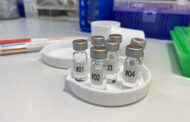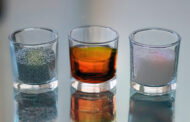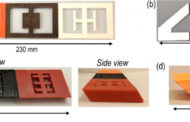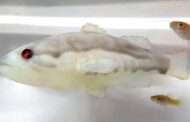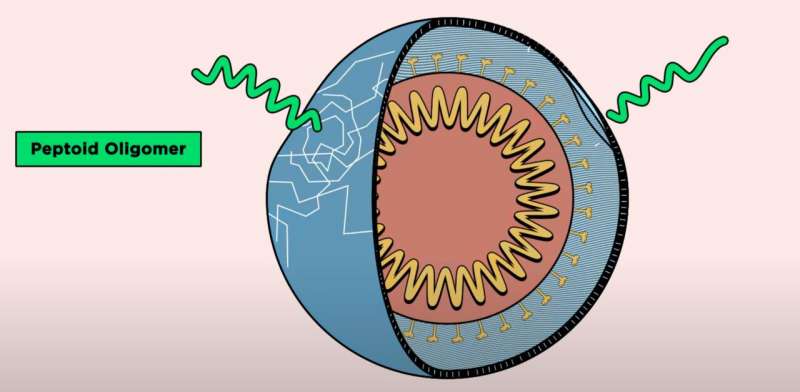
Credit: David Song/NYU
Targeting the membrane of a virus, rather than its proteins, could lead to a new generation of antivirals
Antiviral therapies are notoriously difficult to develop, as viruses can quickly mutate to become resistant to drugs. But what if a new generation of antivirals ignores the fast-mutating proteins on the surface of viruses and instead disrupts their protective layers?
“We found an Achilles heel of many viruses: their bubble-like membranes. Exploiting this vulnerability and disrupting the membrane is a promising mechanism of action for developing new antivirals,” said Kent Kirshenbaum, professor of chemistry at NYU and the study’s senior author.
In a new study published Aug. 2 in the journal ACS Infectious Diseases, the researchers show how a group of novel molecules inspired by our own immune system inactivates several viruses, including Zika and chikungunya. Their approach may not only lead to drugs that can be used against many viruses, but could also help overcome antiviral resistance.
The urgent need for new antivirals
Viruses have different proteins on their surfaces that are often the targets of therapeutics like monoclonal antibodies and vaccines. But targeting these proteins has limitations, as viruses can quickly evolve, changing the properties of the proteins and making treatments less effective. These limitations were on display when new SARS-CoV-2 variants emerged that evaded both the drugs and the vaccines developed against the original virus.
“There is an urgent need for antiviral agents that act in new ways to inactivate viruses,” said Kirshenbaum. “Ideally, new antivirals won’t be specific to one virus or protein, so they will be ready to treat new viruses that emerge without delay and will be able to overcome the development of resistance.”
“We need to develop this next generation of drugs now and have them on the shelves in order to be ready for the next pandemic threat—and there will be another one, for sure,” added Kirshenbaum.
Drawing inspiration from our immune systems
Our innate immune system combats pathogens by producing antimicrobial peptides, the body’s first line of defense against bacteria, fungi, and viruses. Most viruses that cause disease are encapsulated in membranes made of lipids, and antimicrobial peptides work by disrupting or even bursting these membranes.
While antimicrobial peptides can be synthesized in the lab, they are rarely used to treat infectious diseases in humans because they break down easily and can be toxic to healthy cells. Instead, scientists have developed synthetic materials called peptoids, which have similar chemical backbones to peptides but are better able to break through virus membranes and are less likely to degrade.
“We began to think about how to mimic natural peptides and create molecules with many of the same structural and functional features as peptides, but are composed of something that our bodies won’t be able to rapidly degrade,” said Kirshenbaum.
The researchers investigated seven peptoids, many originally discovered in the lab of Annelise Barron, a co-author of the study who currently leads a lab at Stanford. The NYU team studied the antiviral effects of the peptoids against four viruses: three enveloped in membranes (Zika, Rift Valley fever, and chikungunya) and one without (coxsackievirus B3).
“We were particularly interested in studying these viruses as they have no available treatment options,” said Patrick Tate, a chemistry PhD student at NYU and the study’s first author.
How peptoids disrupt viral membranes and avoid other cells
The membranes surrounding viruses are made of different molecules than the virus itself, as lipids are acquired from the host to form membranes. One such lipid, phosphatidylserine, is present in the membrane on the outside of viruses, but is sequestered towards the interior of human cells under normal conditions.
“Because phosphatidylserine is found on the exterior of viruses, it can be a specific target for peptoids to recognize viruses, but not recognize—and therefore spare—our own cells,” said Tate. “Moreover, because viruses acquire lipids from the host rather than encoding from their own genomes, they have better potential to avoid antiviral resistance.”
The researchers tested seven peptoids against the four viruses. They found that the peptoids inactivated all three enveloped viruses—Zika, Rift Valley fever, and chikungunya—by disrupting the virus membrane, but did not disrupt coxsackievirus B3, the only virus without a membrane.
Moreover, chikungunya virus containing higher levels of phosphatidylserine in its membrane was more susceptible to the peptoids. In contrast, a membrane formed exclusively with a different lipid named phosphatidylcholine was not disrupted by the peptoids, suggesting that phosphatidylserine is crucial in order for peptoids to reduce viral activity.
“We’re now starting to understand how peptoids actually exert their antiviral effect—specifically, through the recognition of phosphatidylserine,” said Tate.
The researchers are continuing pre-clinical studies to evaluate the potential of these molecules in fighting viruses and to understand if they can overcome the development of resistance. Their peptoid-focused approach may hold promise for treating a wide range of viruses with membranes that can be difficult to treat, including Ebola, SARS-CoV-2, and herpes.
Original Article: Novel Molecules Fight Viruses by Bursting Their Bubble-like Membranes
More from: New York University | Loyola University Chicago | University of Louisville
The Latest Updates from Bing News
Go deeper with Bing News on:
Antiviral therapies
- Common antibiotic Neosporin may shield against viral respiratory infections
A study conducted first in mice and then in human volunteers suggests that a common antibiotic, neomycin, which is the main active ingredient in Neosporin, may help protect against viral respiratory ...
- Antiviral Combination Therapies Market Seizing Tomorrow Harnessing the Power of Future Market Size Trends
Antiviral Combination Therapies Market is valued approximately USD 40.4 billion in 2019 and is anticipated to grow with a healthy growth rate of more than $ over the forecast period 2020-2027.
- These Are 6 Common ‘Therapy-Speak’ Terms You’re Probably Misusing
Gaslighting is one of the most commonly misused terms, according to experts. It’s a manipulation tactic, often seen in abusive relationship dynamics, in which one person gradually makes the other ...
- Cell Therapy Startup Energized via Smarter Operations
A British-based cell therapy company is using smart operations to streamline its viral vector processing. According to Paul S. Carter, senior director, manufacturing science and technology (MSAT), at ...
- Repurposed nasal antibiotic neomycin shows promise in preventing and treating respiratory viral infections
Intranasal administration of neomycin sulfate in murine models shows promise as a prophylactic and therapeutic agent against respiratory viruses like influenza A and SARS-CoV-2 by inducing ...
Go deeper with Bing News on:
Antivirals
- BRIEF—FDA approves Biktarvy label update
This update makes Biktarvy the only second-generation integrase strand transfer inhibitor (INSTI)-based single-tablet regimen (STR) with in-label clinical trial data and FDA approval in virologically ...
- What is Bell’s palsy, the paralysis affecting 76er Joel Embiid?
Philadelphia 76ers All-Star center Joel Embiid has been diagnosed with Bell’s palsy, a condition that can strike out of the blue and cause muscles on one side of a person’s face to become weak or ...
- Identifying efficacious SARS-CoV-2 antivirals in a changing immune landscape
With almost 775 million COVID-19 cases reported worldwide and 67% of the global population vaccinated with a complete primary series of a COVID-19 vaccine, the deadly pace of the pandemic has slowed ...
- The Era of Direct-acting Antivirals Has Begun
Lower Limit of Detection (LLOD) Versus Lower Limit of Quantification (LLOQ) The LLOD is the HCV RNA concentration at which less than 5% of the samples that contain a known amount of an RNA ...
- 'Common sense for hep B patients to get antivirals'
It is “widely known medical knowledge” that hepatitis B patients taking steroids should also be prescribed antivirals, a renal specialist told the ...




